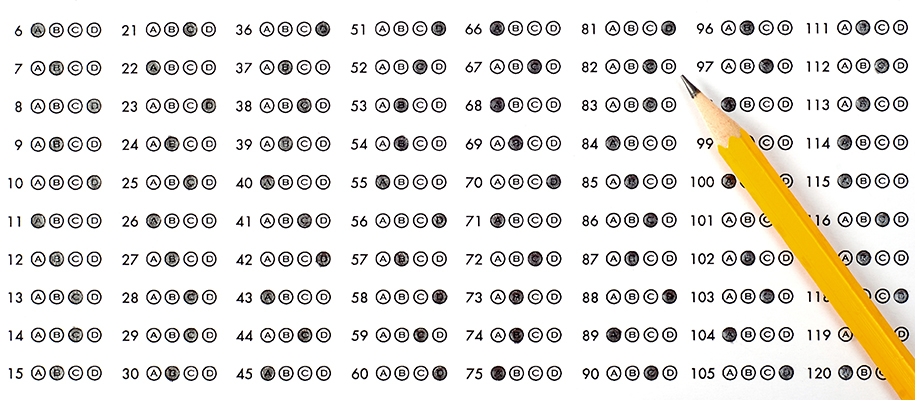The United States is home to some of the world’s leading universities, and they welcome students from all over the world to prepare for their future careers. If you’re interested in studying in the US as an international student, it’s important to know universities vary widely in terms of application requirements, and international students normally have additional requirements on top of the regular admission process. One important piece of this process is standardized testing. Here’s a breakdown of general admission and English-language proficiency testing requirements you should be aware of as a prospective international student heading to the US.
The SAT and ACT
The SAT and ACT are two standardized tests used to measure university applicants’ academic potential. Both test on general knowledge like reading comprehension, writing and language skills, and computational ability. The ACT specifically also tests students on their prowess in science. International students have historically preferred the SAT out of familiarity and broad availability, but this has changed: Both tests are now available around the world, and most universities accept scores from either, so you should choose the test that suits your abilities best. But what are the main differences between the SAT and ACT?
SAT
The SAT consists of two big, multi-topic sections: Reading & Writing and Math. Reading & Writing will test your comprehension and ability to draw conclusions from passages you read as well as your ability to make edits and improvements for a text. Math covers a range of topics in arithmetic, algebra, geometry, and data analysis, with an emphasis on problem-solving. The SAT recently made a huge shift in switching to a digital format, and they restructured the test to fit this format. Check out the SAT Suite at College Board to learn more about the timeframe and scoring of the new Digital SAT.
ACT
The ACT tests similar subject areas as the SAT with some slight differences, covering four main sections and an optional essay. English asks you to make edits or answer questions about a passage to measure your understanding and grasp of standard English grammar and writing conventions. And the complementary Reading section will test your ability to read closely, draw conclusions, and integrate information from multiple sources. The Math section also covers a lot of the same areas as the SAT and some additional ones, with topics like arithmetic, algebra, geometry, trigonometry, and probability and statistics.
Science Reasoning, on the other hand, is a subject completely absent from the SAT and measures your ability to interpret and solve problems in the natural sciences, including biology, chemistry, earth and space sciences, and physics. And the optional Essay section (which the SAT used to have) will describe a complex issue and ask you to adopt one of three perspectives and write an essay comparing your perspective to others. This won’t affect your composite score.
Which test should you take?
The SAT and ACT are clearly similar, but these few key differentiators should help you decide which is best for you:
- Length of the exam: With the new Digital SAT, the ACT is both long and has a significantly higher number of questions. While you think this would mean feeling less rushed as you have more time, the SAT having fewer sections broken into larger chunks of time, even if the overall test-taking time is shorter, is actually beneficial for you if you’re testing in a second language. Having more time in each section means you don’t have to work about being forced to move on to the next section too soon.
- Language differences: English, Reading, and Writing make up half your score on both the SAT and ACT, so if English isn’t your strongest language, there’s no clear advantage to one test over the other. However, many international students remark on the ACT’s tendency to include lesser-known idioms, which can be difficult for non-native speakers to translate in context.
- Science Reasoning section: Where the SAT will only refer to the sciences as part of a reading passage (if at all), the ACT’s Science Reasoning section makes up one-fourth of your score. Being an expert in the natural sciences isn’t necessary, but it’s recommended to have at least completed introductory science courses. If you have a strong science background, the ACT may be a good choice for you.
- Math differences: The ACT and SAT focus on slightly different math topics. There are also other differences in resource assistance—for instance, the SAT provides a guide to common formulas, unlike the ACT, but is also more restrictive on calculator use.
- practice questions to see if you feel more comfortable with one test’s language usage over the other and to study up on English idioms regardless of which test you decide to take.
- Scoring differences: The most important difference is the scoring of the two exams. Because of the inclusion of a Science Reasoning section, math makes up only 25% of your score on the ACT as opposed to the 50% it would account for on the SAT. Your comfort level with math versus science as subjects should heavily factor into your decision.
Once you decide which test you’ll take, you should visit the SAT and ACT websites for up-to-date information on test dates and centers near you.
English-language proficiency tests
If English isn’t your first language, or your educational instruction is in a language other than English, most US universities will require you to submit proof of English proficiency. The type of proof accepted varies by institution, but most schools accept two common standardized English tests: the TOEFL and IELTS.
The TOEFL
The Test of English as a Foreign Language (TOEFL) is primarily taken for academic purposes and scores are accepted by over 10,000 universities worldwide in over 150 countries as a way of proving English proficiency for undergraduate and graduate programs. The TOEFL is scored on a scale of 1–120 and is four hours in length.
The IELTS
The International English Language Testing System (IELTS) is an English proficiency test used for study, migration, or employment and is widely accepted by US universities. There are two IELTS tests: IELTS Academic and IELTS General. The IELTS Academic is scored on a scale of 1–9 and takes two hours and 45 minutes to complete. Most universities will only accept IELTS Academic as proof of proficiency; the General test tends to be shorter and is geared more toward people immigrating to English-speaking countries.
How do you choose?
Both the TOEFL and IELTS Academic are made up of four sections that test basic reading, listening, speaking, and writing in English. Aside from the obvious contrast in length, there are a few differences.
- Test format: The TOEFL is always computer based, whereas the IELTS can be offered as a paper- or computer-based test. On the speaking section, the TOEFL requires you to speak into a computer microphone, whereas you speak directly to the person administering the test during the IELTS.
- Question type: The TOEFL contains only multiple-choice questions, whereas the IELTS has other types of questions such as fill-in-the-blank or true/false.
- Subject matter: TOEFL questions are all based on academic subject matter, while the IELTS Academic contains academic reading and writing sections but also more general listening and speaking sections focusing on everyday conversation.
- Dialect: Because the TOEFL was developed in the US, it’s written in American English, while the IELTS is written in British English and tends to feel more comfortable to those with experience in a wide variety of dialects. This difference will likely not be large enough to impact your score but could ease your comprehension speed on test day.
Your decision should factor in the convenience of test dates and locations in your area, how you learned English, your comfort level with different styles and dialects, and whether you prefer to test in person or on a computer. Once you decide, take your test early in case you need to test more than once—but not too early, as scores are only valid for two years. Both tests are available worldwide; consult the TOEFL and IELTS websites for information about dates and centers near you.
Related: 2 Easy Study Tips for Both Admission and Language Tests
Test-optional schools
The conversation around test-optional policies at colleges and universities is constantly changing, especially after the pandemic. While some schools are moving toward more permanent policies that place less importance on SAT and ACT scores, some schools are moving back to normal testing requirements now that we are further removed from the pandemic. It’s important to always keep abreast of these changing trends. If you are looking at schools with test-optional policies, they will fall into one of these two broad categories:
- Test-optional schools allow you to decide whether you want to include standardized test scores with your application. Students can submit SAT or ACT scores if they feel they’re representative of their abilities or just omit them entirely.
- Test-flexible schools require some form of test score for admission but allow flexibility around which ones.
It’s important to be aware that even test-optional or test-flexible schools may have different requirements for international students. For example, many schools that don’t require the SAT or ACT from domestic students still require them from international students. Even if no general tests are required, there’s a good chance your prospective schools will still require proof of English proficiency or award scholarships based on test scores. Investigate the requirements for general and English-proficiency testing for international students carefully on both your school’s admission website and, if applicable, the website of the specific program you’re applying to.
Exam waivers
Many universities will waive exams for international students if they’re able to provide other proof of knowledge or proficiency. For example, your school may waive TOEFL or IELTS requirements if you can provide transcripts showing you completed an ESL program or graduated from a high school where English was the sole language of instruction; others might even accept documentation of living or working in an English-speaking country as proof. If you don’t meet English-language testing requirements, you may also be granted conditional admission and be asked to participate in a special program for non-native English speakers. There are many circumstances in which universities will be flexible if you ask.
Applying outside the United States
Interested in applying to schools beyond the United States? Countries and individual universities worldwide vary widely in their requirements for international students, so it’s important to do your homework. After the pandemic and with other growing sociopolitical concerns in varying parts of the world, it's important to know the ways the procedures around students studying in other countries can be affected.
About two years before you plan to apply internationally, begin researching the requirements for each of the schools you’re interested in and anything that could be affecting international travel. Starting your search early will give you plenty of time to familiarize yourself with their requirements, complete any standardized tests, and take care of other complicated processes such as visa applications and financial planning. Most school websites provide clear information on exactly which general knowledge and English-language tests you need to submit and possible exceptions; explore school and program websites carefully, and contact admission staff directly with any questions. There’s no such thing as being too thorough!
Related: The International Student’s University Search: Looking Beyond Rankings and Brand Names
Applying to university as an international student takes hard work and preparation, and standardized admission tests are a big part of that. Unfortunately, nothing remains stagnant so be sure to keep up-to-date on all the changing information surrounding these exams. It will all be worth it when you’re able to take advantage of all the rich experiences and diverse educational opportunities the United States—or wherever in the world you choose to study—has to offer.
Do you want to study outside of your country but don’t know which schools interest you yet? Start looking for your best-fit university on CollegeXpress using our College Search tool!









